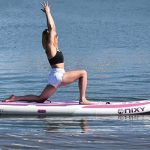Many of us have given yoga a try at one time or another – attempting a restorative Yin class for some peace or engaging in an intense hot yoga class for a thorough workout. It is a widely practiced workout.
Over the past few years, a new type of yoga has come onto the scene, combining it with the growing popularity of stand up paddle boarding (SUP).
But what is SUP yoga? How can you get started? And what paddle board should you choose?
Read on as we answer these questions and more…
WHAT IS SUP YOGA?
Stand-up paddleboard yoga is similar to traditional yoga, however it is done on a paddleboard while out on the water!
You could begin by looking into an SUP Yoga class close to you. A class usually begins with a brief, light paddle to the area where the exercises will be done.
The class then transitions to emphasize yoga, with activities such as mindful breathing while seated, executing the sun salutation pose, and attempting more challenging postures.
Do not be troubled if you lack any knowledge of yoga, you can still reap the benefits of the class.
If you have the good fortune to possess a surfboard, you can work on your yoga poses outside of a class setting. When beginning, pick basic postures before taking on more daring stances.
WHY SHOULD YOU TRY SUP YOGA?
Let us assess five motives for attempting SUP yoga, given its utilization of supplementary benefits for the yogi that aren’t typically found in a traditional yoga course.
1. IT’S SUITABLE FOR ALL LEVELS
A paddle board can bring an extra difficulty to your yoga practice, that affects balance, strength, and suppleness. Nevertheless, people of all ability levels in yoga can get something out of a yoga session on a paddle board, as the challenge of being in the water can help take your practice to another level.
As a beginner, try starting on lakes where the water is typically calmer
Some maneuvers may turn out to be more complicated than anticipated when done on the water. Doing your regular sun salutations will seem like a whole new experience once you decide to take your workout onto the water.
For those just starting out, you might want to begin at a lake, as the water usually is more placid. As you progress in your training, you can test your limits by taking to the sea.
2. IT CAN IMPROVE YOUR STRENGTH AND BALANCE
It’s probable that you can understand that yoga practised on the water is focused on improving balance. Practicing SUP yoga will provide insight into which areas of your balance need improvement and those in which you are proficient.
Incorporating SUP into your yoga practice is terrific for building up your abdominal strength. Ever used a Bosu Ball for exercise? Needing to stay balanced necessitates that you use your core while standing on an erratic surface.
Ever used a Bosu Ball for exercise? Being on an unstable surface requires you to engage your core to maintain balance.
The SUP board behaves in a comparable fashion – its unsteadiness presents a further challenge to the human body, necessitating it to put forth extra effort in order to stay balanced. It is essential that you actively use your muscles in various poses to stay balanced and stable.
3. RECONNECT WITH NATURE
Studies have suggested that spending time outdoors can reduce stress and nervousness, enhance your mood, and promote a sense of joy and contentment. If you have ever practiced yoga in the open air, you can attest to the advantages of being in nature and feeling a mild breeze.
Very few activities can provide one with the same level of proximity to the beauty of nature as paddle boarding. You never know what exciting animals will greet you, the sun’s rays will lift your spirits, and you will definitely enjoy some stunning views.
You won’t find that in any yoga studio.
Research has shown that spending time in nature can help relieve stress and anxiety, improve your mood, and boost feelings of happiness and wellbeing.
Going out on the ocean separates you from the hustle and bustle of daily life. Being surrounded by nature gives you the opportunity to focus your attention internally and to value the current moment during your exercise.
Doing SUP yoga encourages one to take their time and concentrate on breath and body posture.
4. BECOME MORE MINDFUL
As previously mentioned, SUP yoga is centered around maintaining balance. This implies you will cultivate a heightened consciousness of your breathing, physicality and psychological state. Every shift and breath you take will have an impact on your balance while in a pose.
While in a conscious state, you can come back to the simpler poses. Doing even the most basic postures can be tougher when you’re practicing yoga on the water, causing you to pay close attention to the finer points of the poses.
It is impossible to hurry when going through the fundamentals of SUP yoga.
In order to excel at SUP yoga, an intense concentration and equilibrium are needed to maintain balance on the paddle board while transferring between postures.
Where are your hands and feet placed? Is your core engaged? Where is your centre of gravity?
If you don’t have a conscious understanding of your positioning, you could go too far. Making shifts that are seamless and graceful between the poses is necessary for staying balanced on the board. SUP yoga is an incredibly unique form of exercise that involves a complete body workout.
5. HAVE FUN!
Finally, SUP yoga is a lot of fun! It is possible to be too serious in yoga sessions and in other areas of life.
There is no place for boasting when sailing. You let the practice guide you wherever it decides to go in that day. This could potentially push you off your skis, so the only thing to do is to chuckle, shake it off, and return to your board!
There’s no room for ego when you’re out on the water.
SUP yoga is about pushing past the restraints of what you think your skills are, while overcoming the typical apprehension of failing. SUP Yoga is an ideal spot to make a misstep. Embrace the falls!
Why paddle board yoga?
First, it isn’t as difficult as it looks. When you are confident riding a paddle board and can travel between points without much difficulty, you can start attempting a few simple stances.
Replace the heat of the gym with the outdoors by practicing SUP yoga to further develop your yoga expertise. Besides getting a tiny anchor, no other equipment or garments should be required.
In conclusion, it is both enjoyable and rewarding to attempt yoga and meditations in the water as it is a difficult task.
Gearing up for SUP yoga
Stand up paddle board:
Although several businesses are manufacturing Yoga SUPs, it is not integral to have a specialized yoga board to begin. Search for boards that are flat and have a consistent shape that don’t have much curvature.
The mat should be maximized in size so that you will feel relaxed while performing poses. A full-length deck pad is ideal.
If you have not had much exposure to Stand Up Paddleboarding, you may be questioning which kind of paddleboard is preferable for doing yoga – a hard board or an inflatable one. It’s not a significant distinction when it comes to SUP yoga, compared to other paddleboarding varieties.
The breadth, stabilisation, and a sizeable surface for the deck pad should be taken into account for higher priority. Purpose built yoga boards are usually you’re best option.
Attending a paddle board yoga lesson with an experienced tutor who can offer you access to a yoga board can help you determine if obtaining a specialized SUP yoga board will be advantageous to you.
If you develop a fondness for Stand Up Paddleboard Yoga, you should start researching the types of boards available for this specific activity. Discover which yoga paddle board is right for you.
PFD (Personal Flotation Device):
It is often mandatory to possess a personal flotation device whenever paddle boarding. Strangely, it is not always mandatory to wear a personal flotation device (check local restrictions); the US Coast Guard insists that adults should have a PFD on their paddle board.
The best location for your yoga board would be in the bungee cord cargo holder that the board has. It is essential to have an emergency whistle and make sure it is affixed to the personal flotation device. If you wish to wear a personal flotation device while performing stand up paddleboard yoga, find a style that doesn’t restrict your movements too much.
There are also types of PFDs that self-inflate, so they take up significantly less space than the more traditional models. Wearing them will be barely noticeable.
Leash:
A leash ensures that you stay connected to your stand-up paddleboard so if you tumble from your yoga board, it will always be in close proximity. Most people will attach the leash to their ankle and then take it off when they are firmly in position and ready to start their yoga practice.
If an anchor isn’t employed, keep the leash connected, it won’t be much of an obstacle, and in nearly every yoga posture you won’t be aware of it.
Paddle:
No particular paddles are designed for yoga boards, so just pick a paddle that you feel comfortable using. When practicing SUP yoga, ensure you connect your paddle to your paddle board leash securely, using the ankle strap.
Make sure the fit is snug enough to keep the paddle from coming off. If you have an inflatable paddle board, you can fasten your paddle to the D-rings along the side using velcro straps. How to properly size your paddle.
Anchor:
Although it is not compulsory, practising SUP yoga without a mooring can be a challenge, particularly if you are in a group. Doing yoga while stand-up paddle boarding can be disrupted if you regularly have to paddle to avoid drift away from the shore, other people, etc.
A grapnel anchor that weighs three pounds will be enough to hold a paddleboard steady in the water and is both cost-effective and easy to use. Secure at least ten feet of nylon rope to the leash plug on your surfboard. Wrap the rope around the tail of the stand up paddle board and put the anchor on top of it so it stays in place when you are paddling to where you will do yoga.
Once you have identified an area that is as deep or not deeper than the length of your rope, drop the anchor off the side of the boat until it touches the bottom. Tie up any remaining rope that is left over. Now you’re ready to begin your SUP yoga session.
If you are part of a group, one way to stay near each other while on your yoga paddle boards is to connect them together, however it is much simpler to just have everyone anchor their boards close to one another. Anchors simply make yoga SUPs easier to use.
What to wear for sup yoga?
Basically, it boils down to determining if you should wear swimwear or sportswear for your activity. Wearing a swimsuit would be your best option if you are worried about accidentally going into the water. Sunscreen! Never SUP without it.
Yoga or exercise clothing is great for SUP yoga, as it is intended to take moisture away from your body, which means that any splashing you may encounter during your workout will not damage your clothes; by the end of your session, you’ll be perspiring in any case.
Rash guards provide an ideal accessory for active individuals looking to make a splash; as they are specifically intended to become saturated with water, and offer an enhanced level of comfort when it comes to movement. They also provide needed UV protection.
The disadvantage is that although these materials are intended to be exposed to water, some fabrics may locks in the moisture and make you feel uncomfortable.
Swimwear: Most swimwear is fine for paddle board yoga. Board shorts for men can be acceptable, however, it is important that they are not excessively loose and enable one to move unrestrictedly.
Guys will need to put on shirts to prevent themselves from being exposed to too much UV radiation and to feel more at ease when boarding a paddle board.
Women can wear either bikinis or one-piece suits while exercising, but it is a good idea to try out the outfit beforehand to avoid any wardrobe malfunction. It’s essential to pick clothes that fit you properly and won’t require you to keep adjusting them while you practice your poses.
It is recommended that you go shoeless while you are paddle boarding in a yoga session. However, you can still wear sandals or water shoes if necessary.
Not wearing shoes will assist in attaining a greater feeling of solidarity with the paddle board and staying relaxed with your toes to stop “clenching” the deck cushion becomes an extra part of being aware.
Look for sunglasses with total UV shield and attach hairband-like accessories such as “CHUMS” to the arms of the glasses to make sure they don’t come off. witnessing a nice pair of sunglasses sink into the depths of the ocean can be one of the most upsetting experiences.




